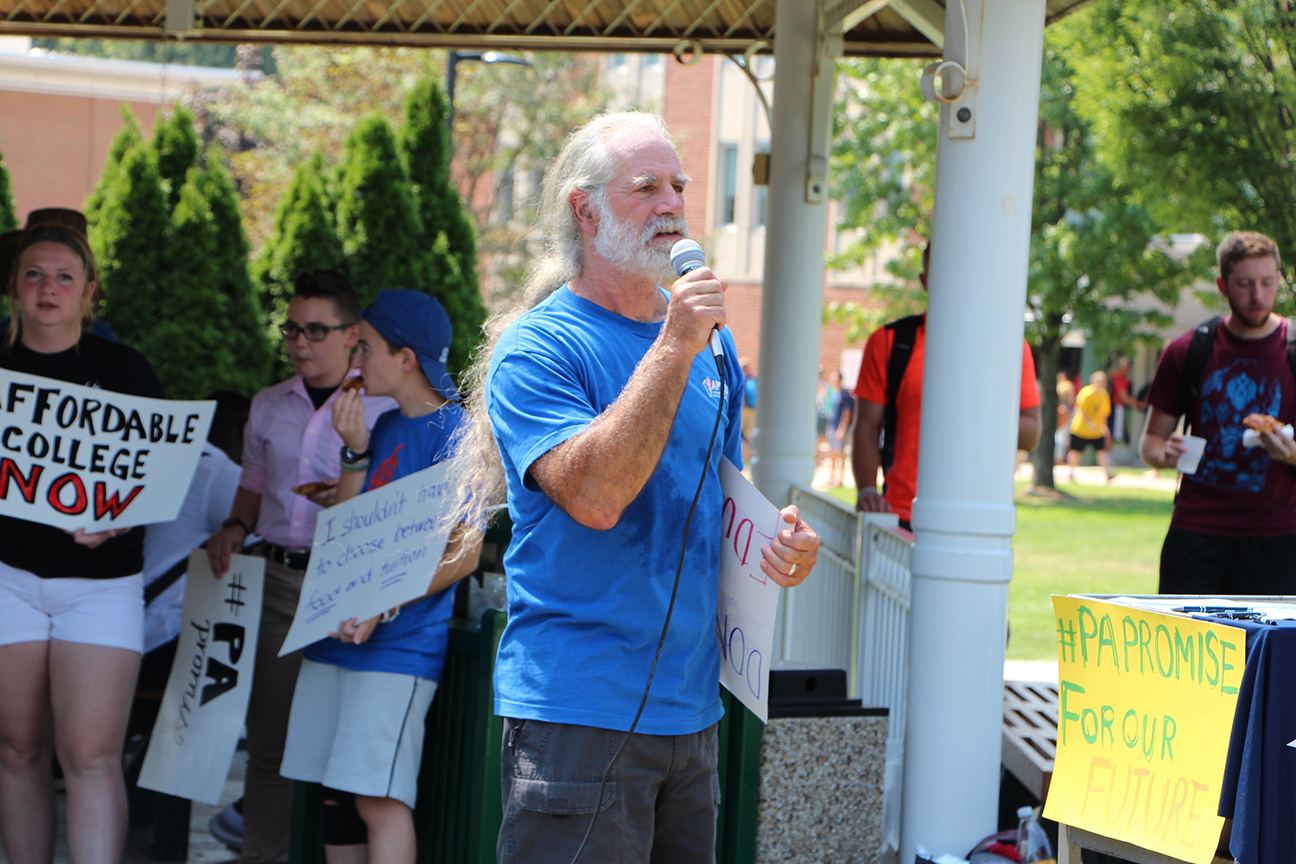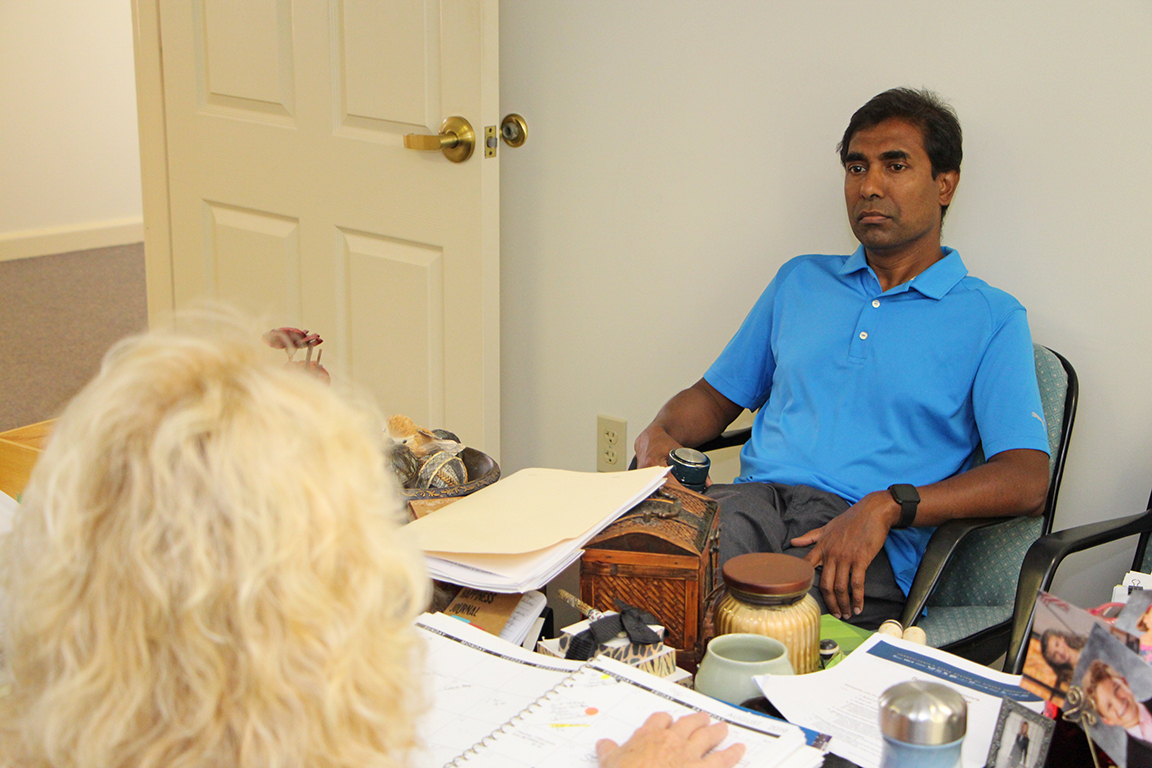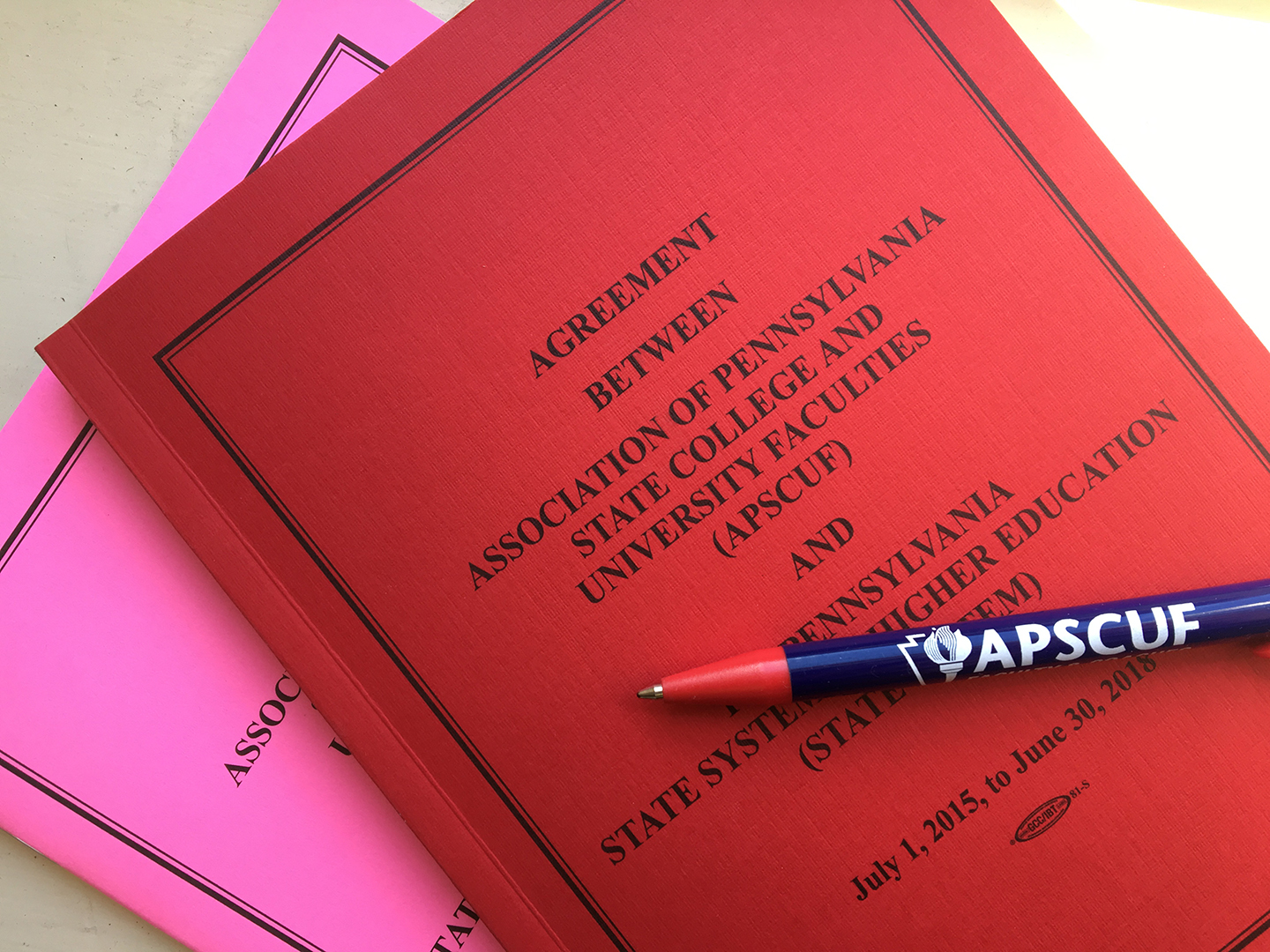Blog
New officer-at-large ready to tackle challenges

Ben Shaevitz encourages students to support the Pennsylvania Promise at a 2018 rally at Slippery Rock University. Shaevitz is APSCUF’s newest officer-at-large on executive council. File photo
When a seat opened on the State APSCUF executive council, Ben Shaevitz saw it as the perfect opportunity to further give back to his union. As a new officer-at-large, the Slippery Rock University professor is bringing with him three decades of State System service and a track record of commitment to his union.
Shaevitz has been involved with APSCUF in a variety of capacities, including as a delegate to legislative assembly and on SRU APSCUF’s executive council. He took a step back while chairing his department, but in 2015, in what Shaevitz called “a confluence of events,” he was named the SRU chapter president and tasked with preparing his fellow faculty members for the next year’s strike.
“(Getting the staff ready for the strike) cemented in my mind the importance of APSCUF,” Shaevitz said.
Comparing union work to public service, Shaevitz said this work is rewarding and gives him the chance to interact with others and meet professors from different universities.
“(The executive council) must process information, collaborate effectively, and do their homework quickly — all in real time,” he said, calling EC’s work important and expressing his excitement to be part of it.
While Shaevitz said this new role is harder to prepare for than one of his lectures, he said he is excited to be working with real people committed to the union.
“APSCUF has history, tradition, and commitment,” Shaevitz said.
Shaevitz’ leadership experiences helped ground him in his work and led him on a path toward greater union involvement, he said. He has been with the Slippery Rock physics department for 30 years, serving as the department chair for 14 years. He earned his B.S. from Purdue University and Ph.D. from the Pennsylvania State University.
Shaevitz encouraged any faculty member with an issue to reach out to him.
“(The executive council is) a representative body,” he said. “We represent our faculty members.”
—Abbey Ford, APSCUF intern
APSCUF welcomes faculty intern from Kutztown University

Kutztown University Professor Mahfuzul Khondaker, right, learns about APSCUF’s labor-relations department from Mary Rita Duvall, head of the department. Photo/Kathryn Morton
We are thrilled to have Mahfuzul Khondaker, a criminal-justice professor at Kutztown University, as our faculty intern this week. He will be in the Harrisburg office interacting with staff members and observing the spectrum of union administration. Click here to learn more about APSCUF’s faculty/coach internship.
See Dr. Kenneth M. Mash’s remarks to the Board of Governors – July 11, 2019
APSCUF President Dr. Kenneth M. Mash’s comments were extemporaneous. Below is the transcription from the video.
I just want to point out for the purposes of understanding that APSCUF is in agreement with this chair and previous chairs that we will speak during public comment, but it is in the contract that we can address the board independently.
It’s been an interesting couple of days here. I had an urge yesterday to get up during public comments and talk, but I wanted to have a more heartfelt expression of what I wanted to get forward today, and I didn’t want to do it in front of the cameras that were here, and I didn’t want to detract from the students who came here, quite earnestly, to talk about the cost of public higher education — a very real impact on their lives and what it means, every single dollar, when tuition or costs at the universities go up.
I have told this story to others, but there was an issue that had happened at East Stroudsburg and a bunch of faculty members decided they were going to go to a Council of Trustees meeting — and I’ve been to a bunch before and witnessed them. My colleague was sitting next to me; it was the first time he’d ever gone to one. After a while watching the Council of Trustees meeting go on, he leaned over to me and he said, “I think I took too much medication today,” and I laughed and said, “What are you talking about?” He said, “This sort of seems like our university but it’s really not what our university looks like. There’s really a great deal of distance here.” And I said, “You’re right, it’s true, you know I’ve served on boards. We’re working on the ground, the Council of Trustees is kind of at 10,000 feet, the Board of Governors is at 50,000 feet, and the legislature is somewhere out in space when it comes to understanding what happens and what actually goes on at our universities.”
I’m very glad about some of the things that have been going on. I originally thought I was going to term this under the category of “responsibility” and “taking responsibility,” but I’m certainly willing to defer to the chancellor’s term and that is “accountability.”
We hear about this financial crisis that is going on at the System and our universities, and certainly it is a financial crisis for those people who have to work at the universities — for our university presidents who are going to have to face very difficult decisions. It really does impact, even more, and the pain really is felt much more by those people who have to work directly with the students every single day. They are the ones who are going to witness major cuts to their departmental budgets and try to figure out how they’re going to make things work.
We’re going to see internships and other experiences, I’m sure, cut like they have been cut before. But really there has been, I do think in the past, a real crisis in accountability as we go up the chain. I’m really glad that Trustee Smith is talking about what they want to do to try and make the Councils of Trustees more accountable. I’m very, very happy by what the chancellor has done and, Madam Chairwoman, what you are doing about talking about making the board more accountable as well. But there has to be at some point ownership. Ownership over the situation that we are in — and the simple reality of this is: Pennsylvania ranks 47th/48th in the country when it comes to almost every single measure of funding for our universities. There’s no hiding from that. It has to be worn by those people who are making the policy decisions — that this is the situation. It’s very easy to point at the board and, through some misunderstanding even from the students, to say, “Hey board, don’t do this. Stop raising costs,” without understanding just how bad that is. U.S. News & World Report ranks Pennsylvania 50th when it comes to higher education. 50th. Nobody should be proud about that. No one in the legislature, no one in the governor’s office should run away from that fact.
The costs don’t go up at our universities because the presidents are making decisions. Even decisions that the board is making, they’re not the ones forcing the costs to rise. What’s happening is it takes money to run universities, and we’re not the same universities we used to be. Every single day — it’s amazing, it really truly is — the chancellor said yesterday, it is amazing that at our universities, students learn to the degree that they do, that there’s amazing things happening in the classrooms, that there’s innovation going on regularly.
I was happy yesterday to hear some presidents talk about athletics and the coaches and the important jobs that they do as far as retention goes. The amazing job that they do helping their student athletes succeed, doing so even with the increasing pressure to raise funds independently to run their programs. The same thing is true of faculty as they try and search around for ways to keep things going.
I hear it all the time that “We can’t be everything to everyone.” Trust me, we are not everything to everyone. We have seen programs go away, we have seen universities shrink, we have seen cuts to faculty, we have seen cuts to student support services all around.
Someone in Harrisburg, some people in Harrisburg have to take responsibility for the decisions that are being made. We are 50th — 50th — in the country. The amount of loans that our students are taking out is not due to the fact that the board is raising tuition or that there are decisions about housing — that’s not what it is. We are not getting properly funded. When this system was created, two-thirds of the cost was paid for by the Commonwealth. Now we’re down to 25% and at some of our campuses, because of the tuition structure, it is lower than that. That is not a situation for success. It doesn’t help the individual students in this Commonwealth, and it doesn’t help the Commonwealth overall.
Students who are bearing that debt cannot any longer buy houses, buy cars, start families when people of our generation started their families. And that decision in this situation is a conscious policy decision — and I’m not making a partisan argument. There was a cut in 2011. That money hasn’t gone up, but if you look at the dates before 2011, under different leadership, the money that was going to the System was already going down, and there were decisions that were made at that point about funding for buildings and other situations that made it continuously more difficult for our universities to do their jobs.
There is certainly room for us to be more accountable, and we should be. We should be held accountable by our students. We should be held accountable by the legislature. We should be held accountable by all the people of Pennsylvania. But the people who work at Harrisburg, they have to take accountability, too. They have to take ownership over the situation that is being created. It’s just too easy to say, “Oh these are hard decisions, now you’re gonna have to make hard decisions.” And then the presidents will go back to their provosts and other vice presidents and say, “You have to make hard decisions.” And they’ll go to the department chairs and say, “You have to make hard decisions.” And the department chairs will go to the faculty and say, “You have to make hard decisions.” And then they will throw up their arms and say, “What do you want me to do? What do you want me to do? I can’t just make it work out of nothing.”
This is a gambit, I understand and I think overall looking at it, it’s the right move to make to not raise tuition. We’ve been doing the same thing for so long: We don’t get proper funding, we raise tuition a little bit. Along the way, that little bit makes a difference for the students. It accumulates over time.
I hope that people listen, that they go back and they talk to the leadership that was there and say, “All right, this is what you wanted to see, this is what is happening. You wanted more accountability. That is happening. You need to take accountability now. You have to take ownership, you have to wear that number 50 really like it is a scarlet letter and understand the harm that is being done to our individual students and overall to the Commonwealth.”
Thank you Madam Chair, Chancellor, presidents, too — for the increase in discussions about accountability. We’ve had some interesting conversations at negotiations about accountability as well, and I can only hope that we will all work together — students, presidents, trustees, the board, legislators who are on the board — to try and do better for the people of Pennsylvania.
Thank you very much.
Negotiations continue after expiration date

After faculty and coach contracts expired June 30, APSCUF negotiations continue with Pennsylvania’s State System of Higher Education. By law, those collective bargaining agreements remain in effect until new ones are ratified.
Faculty negotiators are next scheduled to meet July 17–18 and 22–23. Click here and here to read about June’s negotiations.
Coach negotiators met today. Click here to read about that session. The next coach negotiations are slated for Aug. 5–6 in Harrisburg.
Members can stay up-to-date on negotiations news by subscribing to this blog (enter your email address in right column on this page) and registering for negotiations updates.
APSCUF members advocate for quality, affordability

APSCUF members assemble on Lt. Gov. John Fetterman’s balcony June 12 before fanning out into the Capitol to advocate for quality, affordable higher education. Photo/Kathryn Morton
APSCUF members talked with legislators and union supporters about higher-education issues and our 14 universities at APSCUF’s Legislative Reception Tuesday, June 11, at The Capital Gastropub. The following day, they visited the Capitol to advocate for quality, affordable public higher education in Pennsylvania. Thanks to all who joined us last week. View additional photos on APSCUF’s Facebook page.